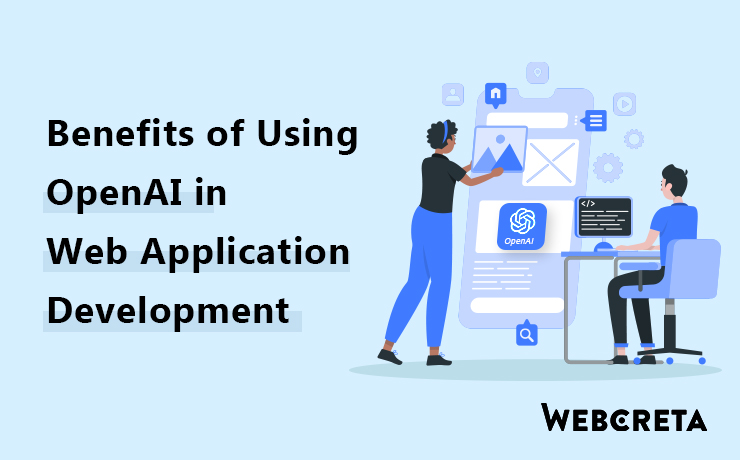Benefits of Using OpenAI in Web Application Development

Table of Contents
In an era marked by rapid technological advancements, artificial intelligence (AI) has emerged as a transformative force, reshaping industries, enhancing user experiences, and opening new horizons of possibilities. Among the pioneers in the field, OpenAI stands out as an exemplar of innovation, offering tools and technologies that empower developers, businesses, and end-users alike.
As businesses strive to meet the ever-changing needs of their customers, OpenAI-based solutions are becoming a crucial element in creating intelligent, responsive, and highly personalized digital experiences. Whether it’s automating customer service through intelligent chatbots, offering personalized recommendations, enhancing security through fraud detection, or revolutionizing accessibility, OpenAI offers an array of capabilities that transcend traditional computing limitations.
But what does it mean to develop a solution with OpenAI? What opportunities and challenges lie in harnessing the immense potential of this cutting-edge technology? How can businesses and developers leverage OpenAI to create solutions that are not just innovative but also ethical, inclusive, and sustainable?
This blog will explore the exciting world of OpenAI, diving into its underlying principles, showcasing real-world applications, and providing insights into developing OpenAI-based solutions. Whether you are a seasoned developer, a business leader looking to innovate, or someone simply fascinated by the transformative power of AI, this blog will serve as a comprehensive guide to understanding and leveraging OpenAI. Join us as we embark on a journey through the intricacies of OpenAI and discover how it’s shaping the digital landscape for a smarter, more connected future.
Personalized Experiences
Through machine learning and data analysis, OpenAI can create a profile of a user’s preferences and behaviors. This leads to an individualized and more engaging user experience. OpenAI’s algorithms analyze various factors such as search history, purchase history, click patterns, and even time spent on specific pages. This analysis helps in dynamically generating content, offers, or suggestions specifically tailored to an individual user. It’s like having a personal assistant who knows your tastes and needs, providing you with exactly what you’re looking for without you having to sift through irrelevant content.
Example: Netflix Movie Recommendations
Netflix employs AI algorithms that analyze your watching habits, the ratings you give, and the time you spend on certain genres. Based on this data, it offers a tailored list of movies and shows you’re likely to enjoy. The more you watch, the more refined these recommendations become.
Faster Customer Support with AI Chatbots
AI chatbots provide immediate, automated responses to customer inquiries, leading to faster resolutions and higher customer satisfaction. These chatbots are designed to understand and respond to natural human language, making them intuitive and easy to interact with. They can handle a wide variety of tasks, from answering common queries to processing simple transactions, even when human support agents are unavailable. This immediate response reduces waiting time, alleviates frustration, and enhances the overall customer experience.
Example: H&M’s Ada Chatbot
Fashion retailer H&M’s chatbot, Ada, assists customers with everything from tracking orders to finding specific clothing items. It understands natural language, making interaction intuitive and efficient, without the need for human intervention.
Natural Language Interaction
This feature enables users to interact with an application just like they would with a human, using voice commands or conversational text. OpenAI’s Natural Language Processing (NLP) understands the context, sentiment, and intention behind user input, allowing for more intuitive interaction. It bridges the gap between human language and computer understanding, enabling users to communicate with applications in a way that feels natural and human-like. This leads to a more engaging and enjoyable user experience.
Example: Google Assistant in Google Maps
Google Assistant’s integration with Google Maps allows you to ask for directions, call businesses, and even add stops to your route using natural language. You can simply say, “Find a gas station on my route,” and the assistant will provide options without you having to type or leave the navigation interface.
Enhanced Security and Fraud Protection
AI algorithms provide additional layers of security by constantly monitoring and analyzing user behavior and transaction patterns to detect fraudulent activities. These models are trained on vast amounts of data, allowing them to recognize subtle, abnormal patterns that might indicate fraudulent activity. This real-time monitoring adds an essential layer of security, providing immediate alerts and potentially stopping fraudulent transactions before they even occur. It brings a level of sophistication to security measures that manual monitoring could never achieve.
Example: PayPal’s Fraud Detection
PayPal uses machine learning to analyze millions of transactions. If it detects unusual activity, like a sudden large purchase in a foreign country, it will flag the transaction and alert the user, possibly preventing fraudulent activity.
Predictive Features for Convenience
Predictive analytics use historical data to forecast future events, adding a layer of convenience to applications. Whether it’s predicting traffic conditions, weather patterns, or product availability, OpenAI’s predictive models analyze past trends and current conditions to forecast future occurrences. This foresight allows users to plan and make decisions proactively, providing convenience and efficiency in various aspects of daily life.
Example: Weather Prediction in Agricultural Apps
Farmers can utilize apps with OpenAI-powered weather prediction to plan their farming activities. By predicting weather patterns, these apps help farmers decide the best time to plant, irrigate, and harvest crops, maximizing yield and efficiency.
Accessibility Features for All Users
OpenAI ensures that web applications are accessible to all users, including those with disabilities, through features like voice commands and image recognition. OpenAI’s accessibility features are designed to provide alternative means of interaction, ensuring that applications are inclusive and accessible to all. For example, visually impaired users can use voice commands to navigate, while AI-driven image recognition can describe visual content to them. This inclusivity not only complies with legal standards but also reflects a humane approach to technology design.
Example: Microsoft’s Seeing AI
Microsoft’s Seeing AI app uses computer vision to describe the world to visually impaired users. It can read documents, recognize products, and even describe people and emotions, making daily tasks more accessible.
Visual Content Enhancement
OpenAI can optimize and even generate visual content, enhancing the visual appeal and user engagement of applications. From optimizing images for faster loading without losing quality to providing augmented reality experiences like virtual try-ons, OpenAI’s visual content enhancement creates engaging and immersive experiences. These algorithms can also generate visual content, such as illustrations or animations, personalized to the user’s preferences and interaction history.
Example: IKEA’s Virtual Furniture Placement
IKEA’s AR app allows you to virtually place furniture in your space through your smartphone camera. OpenAI algorithms provide realistic visualizations, letting you see how a piece of furniture fits and looks in your home before purchasing.
Smarter and Quicker Performance
OpenAI helps applications adapt to varying demand levels, ensuring optimal performance at all times. Through intelligent load balancing, resource allocation, and predictive analytics, OpenAI ensures that applications remain responsive even during peak usage times. It dynamically allocates resources where needed, predicts potential bottlenecks, and adjusts performance parameters in real time. This ensures a smooth, uninterrupted user experience, regardless of the number of simultaneous users.
Example: YouTube’s Video Buffering Optimization
YouTube uses AI to predict your viewing patterns and pre-buffers videos you are likely to watch next. This results in quicker loading times and a smoother viewing experience, even in fluctuating internet conditions.
Encouraging Creativity and New Experiences
OpenAI facilitates creative experiences by providing tools and features that inspire innovation and personalize content. OpenAI’s algorithms can generate creative content, assist in design, and even inspire new ways of interaction. They can provide personalized recommendations for music, generate unique artwork, or assist users in creating their content. These creative tools democratize artistic expression, allowing users to explore and create in ways previously reserved for professionals.
Example: Adobe’s Sensei in Graphic Design
Adobe’s Sensei uses AI to understand your design habits and preferences. It can suggest design elements, optimize images, and even assist in creating visual effects, turning even novice users into skilled designers.
Cost-Effective Services
Automation and intelligent optimization reduce operational costs, often leading to savings for the end users. OpenAI’s ability to automate processes, optimize resources, and even generate content reduces manual effort and associated costs. These savings often translate into more affordable services, free features, or additional content for users. For example, personalized educational content can be provided at a fraction of the cost of traditional tutoring, making quality education more accessible.
Example: Duolingo’s AI-driven Language Lessons
Duolingo offers personalized language learning experiences through AI algorithms that adapt to your learning pace and style. This AI-driven approach reduces the need for human tutors, allowing Duolingo to offer effective language lessons for free or at a low cost.
How can Webcreta Help?
OpenAI in web app development is more than a technological advancement; it’s a paradigm shift in user experience. It empowers applications to learn, adapt, predict, and even create new experiences tailored to individual users. From enhancing everyday tasks like watching videos and shopping online to providing unprecedented accessibility features, OpenAI’s impact on web applications is profound and far-reaching. For end customers, this translates into smarter, more efficient, and more human-centric interactions with technology. It’s not just about convenience; it’s about creating a digital world that is more inclusive, creative, and responsive to our unique needs and preferences.
Let us be your trusted partner in navigating the dynamic world of Artificial Intelligence development. Contact our experts today to embark on an exciting journey toward building your Artificial Intelligence Web App!



